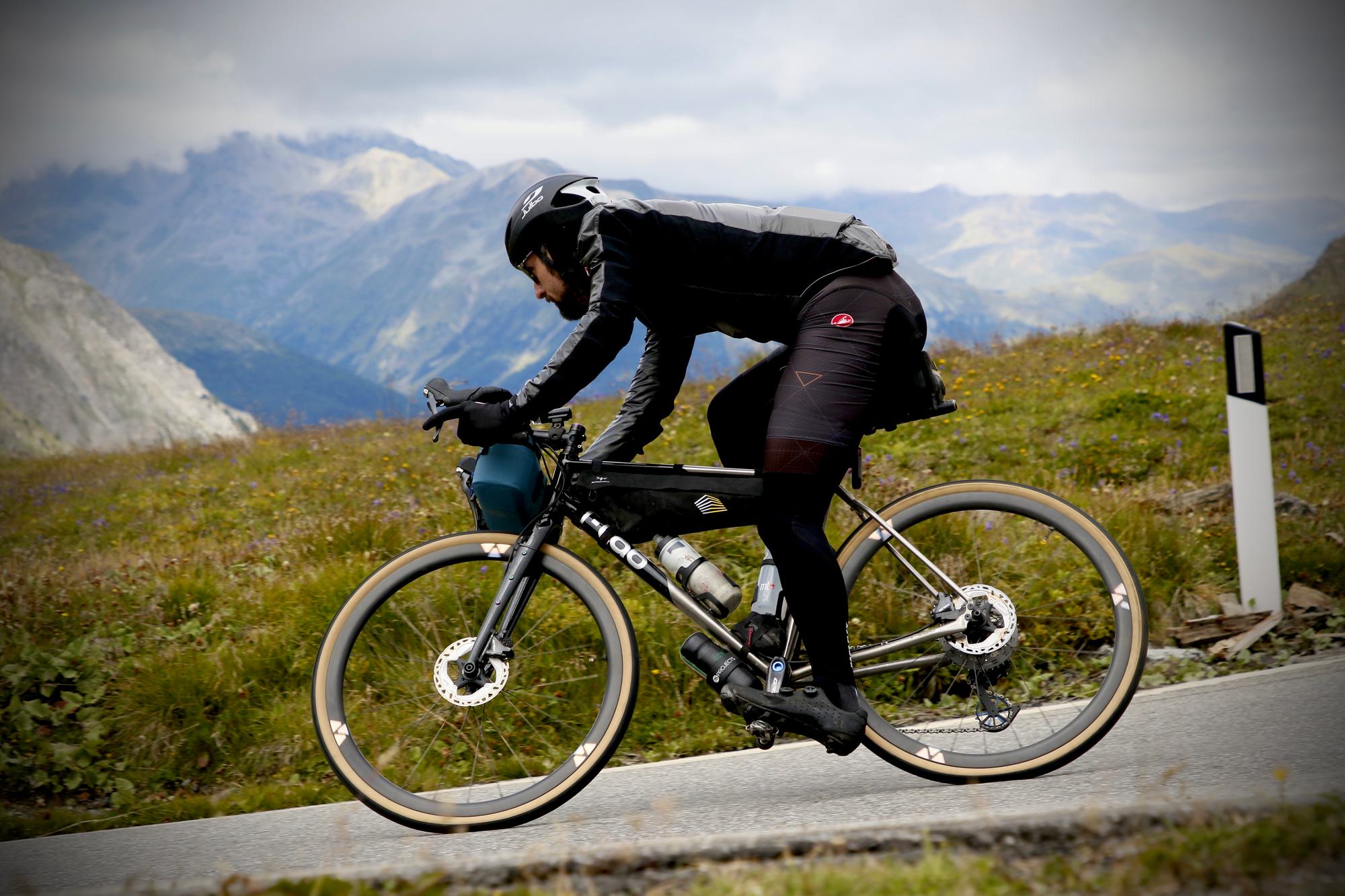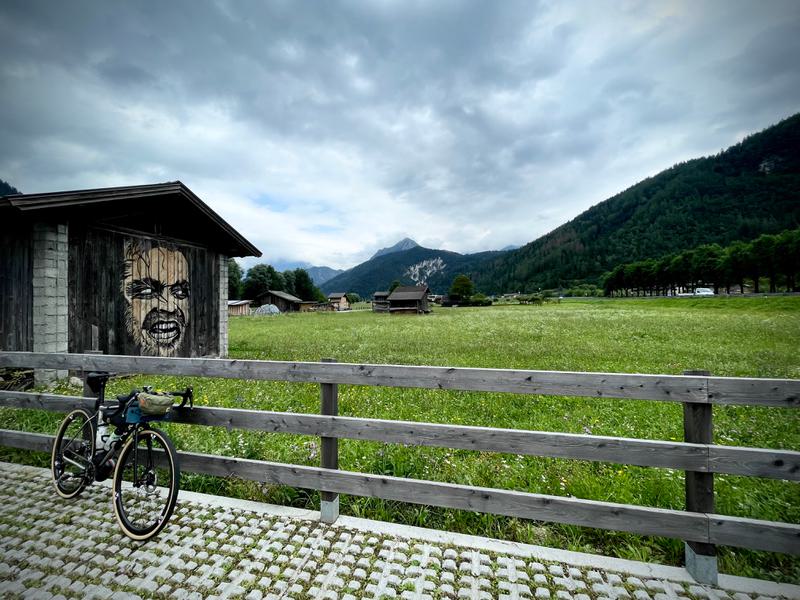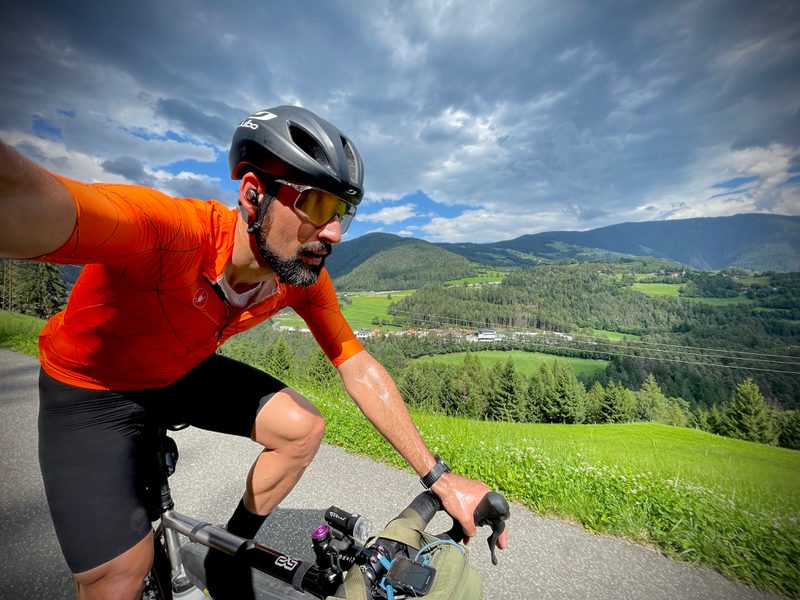
T-LAB – Have Ti bike, will travel.
August 30, 2023
T-LAB – Have Ti bike, will travel.
By Matt Surch (Guest Contributor)
In the mid-1990s, mountain biking was growing at a dizzying pace. Technology was rapidly developing, everything was exuberant and colourful, and the atmosphere at races was electric. I had one bike, and it did everything I needed it to do. 1.5” slick tires for spring road riding, a seatpost-mounted fender for riding to school through winter; whatever it took, I adapted the bike. Seven days a week, it was ‘simple’: keep this bike going and being what it needs to be. Make it work.
I never imagined, couldn’t have imagined, what cycling would become, and how I would develop with and through it. Gravel racing in Vermont with Ned Overend and Tinker Juarez? C’mon; what? That happened. Road racing with local guys who’d become absolute stars at grand tours? Huh? It’s happening. Riding my bike over the Alps solo, more than once, and loving it? C’mon, what? Indeed!
Back in the 90s, riding one bike all the time, I didn’t realize how much I was adapting to its quirks. I had no real reference point for how a good mountain bike should ride when I was on my first proper machine, a Rocky Mountain Vertex. If I was crashing, it was because I was making mistakes, not because the bike’s geometry was whacky. The bike, and mountain bikes in general during this era, wasn’t really an ‘open architecture’ technology. Yes, folks were developing new suspension systems, but they seldom changed the overall geometry and layout of the bike. As I had opportunities to ride different bikes, I quickly realized that I had a hard time adapting to even minute differences between them. I was so locked into understanding my own bike’s characteristics and feedbacks, I wasn’t ready or able to let other bikes tell me how they needed to be ridden. As time passed, one became two, became three bikes, one of which was a downhill bike. I started learning to tune into each platform, sync up, and move toward the bike becoming ‘invisible’ under me. This took days, then hours, then minutes, then seconds, over decades. Today, I can get onto any bike and figure out how to make it work for me in short order. But I remember the feeling of being disconnected and prone. I remember being scared.
Fear is healthy and useful except when it isn’t. Cycling isn’t ‘safe’ in any sense, and I’m pretty certain this has a lot to do with why we enjoy it. In a sense, we’re getting away with something when we ride bikes. At minimum, we’re flying. And that isn’t human!
Flying, figuratively: fun.
Flying, literally: scary.
What, like ‘air-time’ on the bike? Scary to some, sikk to others; this isn’t the kind of flying I’m bridging to.
Flying with our bikes, on airplanes: the stuff of nightmare. On the flip-side, renting bikes at our destinations, and riding them over unfamiliar and demanding terrain: also the stuff of nightmare. Most folks are adapted and synched up with one bike, especially if it’s a versatile one. A versatile bike that covers all or almost all our riding also deserves/makes sense to dial in with all the customizations that make it truly our own, and high-performing for us, be that optimized for speed, comfort, carrying camping gear, or whatever other characteristics and capabilities.
When folks learn I like to ride in Europe, the conversation tends to go something like this:
“Do you rent a bike in Europe?”
“No, I take mine.”
“That must be a pain!”
“Yes and no. I’ve been working on making it less of a pain. It’s worth it for me.”
“I’d be so worried about my bike.”
“Yeah, I know what that’s like. I have a titanium bike now, and this really helps reduce the fear-factor.”
“Oh, like a ‘travel-bike’?”
“Well, yes, and no. It’s my bike-bike now, the one I ride when I’m not on my mountain bike. It does everything I need a drop bar bike to do.”
“Oh, cool.”
“Yeah, I love it.”
Full circle? Sort of, right?
Since April, 2023, all my rides (about 260 hours) have occurred on two bikes: my hardtail mountain bike, and my new T-Lab X3. I built the X3 up at the end of March, flew with it to Nice, France for two weeks riding, then continued on with it functioning as my primary bike. This is the closest I’ve come to ‘having one bike’ since the early ‘90s. I’m loving it.
Sure, I can and have had as many as 7 bikes ready to roll at any given point, and if I wanted to, I could dedicate an older frame to travel. Or I could invest in a ‘travel bike’ frame. Would either make sense, though? If my X3 is optimized for versatility and reliability to cover a huge swath of riding locally, what would I stand to gain by duplicating that?
I’d gain nothing, because my X3 is already both ideal for local riding and travel. The bike gives nothing up that matters compared to other all-road or gravel bikes made from other materials. And I say this having spent beyond extensive time on each of the other three common materials: steel, aluminum, and carbon.
For sure, each of these materials comprise some incredible bikes. And every material, if tuned for exhilarating ride quality, must also necessarily be thin where it can be thin (often less than 1mm). Structurally, this is functional and reliable, while riding the bike. A bike’s Achilles heel, however, is loads and impacts that occur when the bike is not ‘just riding along.’ The absolute most prone a frame can be is when its bare, pre-assembly, Without a headset, bottom bracket, seatpost, and wheel mounted, the frame’s bores can be easily dented, and its rear triangle can be crushed. With parts mounted, try denting a headtube or bottom bracket shell, or crushing a rear triangle. Good luck, it’s not gonna happen.
So a bike, in bike form, it pretty durable, but the higher quality it is, the thinner its tubing and rims, and the more prone it is to damage when not riding. If we’re talking about a road bike, rocks flying around isn’t really going to be common. For a gravel or MTB, heck yes, it’s common. In fact, on carbon bikes for gravel use, it’s borderline ‘nuts’ to skip placing protective tape on the underside of the downtube. On carbon MTBs, its similarly ‘nuts’ not to put a robust protective strip on the downtube, toward protecting it from rock and log strikes that could easily crack the material.
What I’m saying is that riding bikes over mixed terrain already tends to involve a degree of ‘de-risking’, and this de-risking must be amplified as we move from the most to the least robust materials. From an impact resistance perspective, titanium is the most robust frame material, while carbon is the least robust. Yes, there’s relevant nuance here, like the fact that really thin steel can rather easily be dented, as can aluminum. But dents to these materials don’t equate to material ‘breakage’.
When thermoset carbon ‘dents’, it does so by virtue of carbon fibers literally breaking. Carbon fibers are not elastic; they can flex along their length, but they can’t lengthen. So when an foreign object pushes hard enough into a carbon structure, its deformation will transition from flex to breakage. In contrast, metal alloys don’t rely on strands of fiber for their structural integrity. When a foreign object deforms a metal tube, the structure is re-shaped in the same way frames are adjusted for alignment: cold-setting, aka, ‘bending’. Bending metal is another way of saying ‘shaping metal’, which is part of metal fabrication processes all day, every day, everywhere in the world.
Denting a metal bike frame doesn’t necessarily weaken the bike’s structural integrity enough to matter, but it can do. It depends on the material, the location, and depth of the dent. With steel, a dent could wind up causing zero issues across 20+ years of regular riding. On an aluminum frame, a decent dent almost anywhere would tend to lead to cracking, then failure. The good news is that light aluminum is thicker than light steel, and its often a bit harder to dent. In either case, there’s a peace of mind tied to the fact that we can definitely monitor a dent through time and see whether a crack is developing. In other words, we can see whether the frame’s ‘re-shaping’ is crossing over into material failure. With titanium, this is also the case, but it’s significantly harder to dent titanium in the first place. The material is incredibly hard, which makes it resistant to cutting and denting.
In contrast, today’s most popular frame material for performance cycling, carbon fibre, does not afford reliable visual inspection. The material, on paper, has truly impressive qualities and characteristics for bikes. But the material is very sensitive to manufacturing methods and quality control, which means even a brand new frame carries uncertainty; is there a gremlin hiding in there? The lightest carbon frames need to be coupled with the most extensive quality control on top of very precise manufacturing to enable reliability. This is a thing, some brands cross all the Ts and dot all the Is. And the cost of such bikes will tend to be in the $20k range.
If I were to put that much money into a bike, heck yeah, I’d want to ride it in Europe, which amounts to the most intense and demanding riding I do each year. New roads, rocks and livestock on the roads, cars on my side as I round blind turns, precipices to careen off; riding in the mountains in Europe is no joke! I want to ride my best bike, and I want that bike to be utterly dialed. If I’ve put $20k into a bike, it’s my best bike, and it’s dialed. If it’s carbon, it’s also a bike I am going to be terrified to fly with. Oops.
Let’s be real: the most ‘F1’ bikes out there are fragile. It is what it is. When riders want to take fragile bikes on flights, they tend to have to resort to fairly huge hard-cases to protect these bikes. That requirement drives up baggage costs and transport challenges from airport to accommodations. The bike case becomes the tail wagging the dog. Riding options and plans need to be developed around the case’s limitations, which tends to drive riders to base themselves out of locations that are easy to get to from the airport and hunker down. The bike, a flexible tool, is constrained by an inflexible protection for the tool.
I’ve flown three T-Lab X3s with me to Europe now, and my peace of mind has never been better. My latest iteration, the 2023 X3, has served me well in many guises in my region, and I have complete confidence in it as a travel companion. I’m comfortably packing it into my Post Carry Co. Transfer Case, which affords me the greatest flexibility between airports possible, and the ability to ride from locale to locale without burdening my wife with transporting an unwieldy hard-case for me. If I had a fragile superbike, this would not be an option; I’d be constrained. Instead, I my X3 is a durable superbike, and I’m unfettered. Ride bikes, have fun.
Next Time: The little details that matter for a go-anywhere bike.


